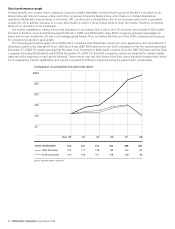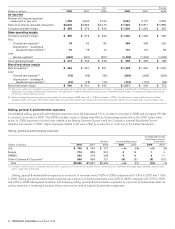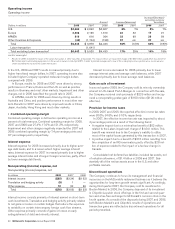McDonalds 2008 Annual Report Download - page 26
Download and view the complete annual report
Please find page 26 of the 2008 McDonalds annual report below. You can navigate through the pages in the report by either clicking on the pages listed below, or by using the keyword search tool below to find specific information within the annual report.traffic. We will also aggressively continue to open new restaurants
in China. We will further build our breakfast business in APMEA by
increasing the number of locations where it is served, utilizing
innovative marketing support and launching new products. At the
same time, we will continue to highlight our classic menu favorites
and offer locally-relevant extensions of these products. In addition,
we are further leveraging a strategic pricing tool to optimize menu
prices to drive sales and profits.
In 2009, we will continue to optimize the mix of franchised and
Company-operated restaurants and will refranchise restaurants
under the previously mentioned target. The speed with which we
make progress toward this goal will depend on our ability to
identify the appropriate prospective franchisees with the experi-
ence and financial resources in the relevant markets. We will also
continue to evaluate several small markets in APMEA and Europe
for potential transition to developmental license structures. We will
only convert such markets when we believe that we have identified
a qualified licensee and our business is ready for transition to
optimize the transaction for the long-term.
As previously discussed, our evolution toward a more heavily
franchised, less capital-intensive business model has favorable
implications for the amount of capital we invest, the strength and
stability of our cash flow and our long-term returns. As a result, we
expect free cash flow — cash from operations less capital
expenditures — will continue to grow and be a significant source to
fund total cash returned to shareholders. In addition, we expect our
share repurchase activity will continue to yield reductions in our
outstanding share count.
Finally, we will continue to be disciplined financially, remaining
diligent about how and where we invest capital and selling, general
and administrative expenses to grow our business. Consistent with
the last few years, to drive sales and returns we will allocate nearly
50% of our $2.1 billion of planned 2009 capital expenditures
toward reinvestments in existing restaurants, mainly related to the
reimaging of locations in Europe and the rollout of the beverage
strategy in the U.S. The remainder of our capital expenditures will
primarily be used to build new locations.
McDonald’s does not provide specific guidance on net income
per share. The following information is provided to assist in analyz-
ing the Company’s results:
• Changes in Systemwide sales are driven by comparable sales
and net restaurant unit expansion. The Company expects net
restaurant additions to add nearly 2 percentage points to 2009
Systemwide sales growth (in constant currencies), most of which
will be due to the 709 net traditional restaurants added in 2008.
• The Company does not generally provide specific guidance on
changes in comparable sales. However, as a perspective, assum-
ing no change in cost structure, a 1 percentage point increase in
comparable sales for either the U.S. or Europe would increase
annual net income per share by about 3 cents.
• With about 75% of McDonald’s grocery bill comprised of 10
different commodities, a basket of goods approach is the most
comprehensive way to look at the Company’s commodity costs.
For the full year 2009, the total basket of goods is expected to
rise about 5% to 5.5% in the U.S. and about 4% to 4.5% in
Europe with more of this pressure occurring in the first half of
the year. Some volatility may be experienced between quarters
in the normal course of business.
• The Company expects full-year 2009 selling, general & admin-
istrative expenses to decline, in constant currencies, although
fluctuations may be experienced between quarters due to cer-
tain items in 2008 such as the biennial Worldwide Owner/
Operator Convention and the Beijing Summer Olympics.
• Based on current interest and foreign currency exchange rates,
the Company expects interest expense in 2009 to be relatively
flat compared with 2008. Interest income in 2009 is expected to
decrease about 80% compared with 2008 due to expected
lower average interest rates and average cash balances.
• A significant part of the Company’s operating income is gen-
erated outside the U.S., and about 45% of its total debt is
denominated in foreign currencies. Accordingly, earnings are
affected by changes in foreign currency exchange rates, partic-
ularly the Euro, British Pound, Australian Dollar and Canadian
Dollar. Collectively, these currencies represent approximately
70% of the Company’s operating income outside the U.S. If all
four of these currencies moved by 10% in the same direction
compared with 2008, the Company’s annual net income per
share would change by about 12 to 15 cents. Due to the recent
strengthening of the U.S. Dollar relative to virtually all foreign
currencies, full year 2009 revenues and operating income will
likely be negatively impacted by foreign currency translation.
• The Company expects the effective income tax rate for the full-
year 2009 to be approximately 29% to 31%. In the normal
course of business and based on the timing of certain trans-
actions and events, some volatility may be experienced between
the quarters resulting in a quarterly tax rate that is outside the
annual range.
• The Company expects capital expenditures for 2009 to be
approximately $2.1 billion. About half of this amount will be
reinvested in existing restaurants while the rest will primarily be
used to open about 1,000 restaurants (950 traditional and 50
satellites). The Company expects net additions of about 650
restaurants (750 net traditional additions and 100 net satellite
closings). These restaurant numbers include new unit openings
(approximately 30%) in affiliated and developmental licensed
markets, such as Japan and Latin America, where the Company
does not fund any capital expenditures.
• For 2007 through 2009, the Company expects to return
$15 billion to $17 billion to shareholders through share
repurchases and dividends, subject to business and market
conditions. For 2007 and 2008 combined, the Company
returned $11.5 billion to shareholders.
• The Company continually reviews its restaurant ownership struc-
tures to optimize cash flow and returns and to enhance local
relevance. The Company expects to refranchise 1,000 to 1,500
Company-operated restaurants between 2008 and 2010,
primarily in its major markets, and by continuing to utilize its
developmental license strategy. In 2008, the Company refran-
chised about 675 restaurants, primarily in its major markets.
• In February 2009, consistent with its focus on the McDonald’s
restaurant business, McDonald’s agreed to sell its minority inter-
est in Redbox Automated Retail, LLC, an automated DVD rental
service. The Company expects to recognize a nonoperating gain
upon the closing of the transaction in first quarter 2009.
24 McDonald’s Corporation Annual Report 2008
























